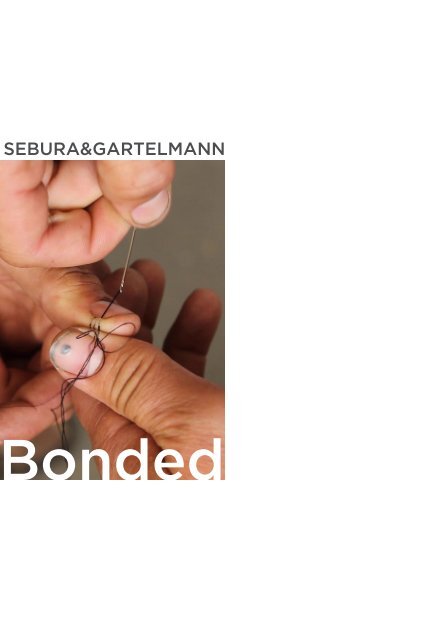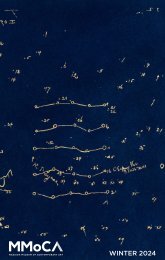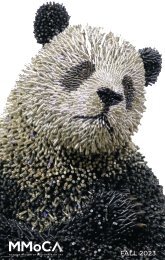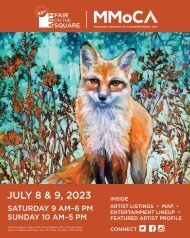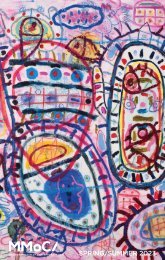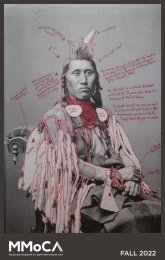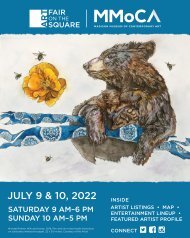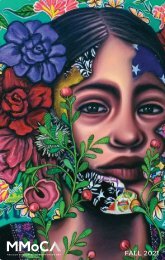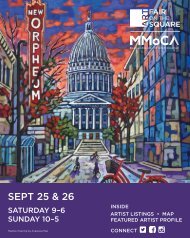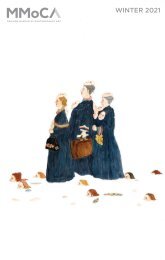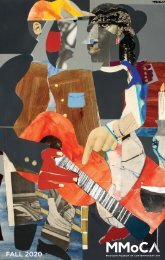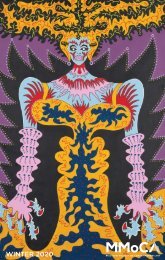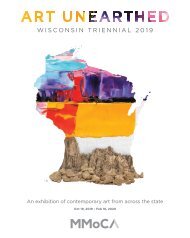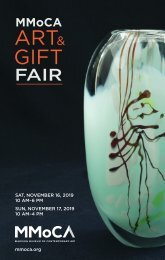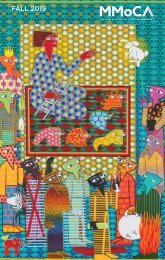Sebura&Gartelmann: Bonded exhibition catalog
Exhibition essay, images, and an interview with the artists. This catalog accompanies the exhibition in the Imprint Gallery.
Exhibition essay, images, and an interview with the artists. This catalog accompanies the exhibition in the Imprint Gallery.
Create successful ePaper yourself
Turn your PDF publications into a flip-book with our unique Google optimized e-Paper software.
SEBURA&GARTELMANN<br />
onded
Sebura&<strong>Gartelmann</strong>:<br />
<strong>Bonded</strong> was held in<br />
the Imprint Gallery at<br />
the Madison Museum of<br />
Contemporary Art from<br />
June 6–September 27,<br />
2020. It was developed<br />
in partnership with the<br />
Art History course Design<br />
Thinking for Exhibits,<br />
at the University of<br />
Wisconsin–Madison.
SEBURA&GARTELMANN:<br />
<strong>Bonded</strong>
Contents<br />
7<br />
10<br />
22<br />
23<br />
24<br />
25<br />
28<br />
42<br />
43<br />
Forward<br />
by Elizabeth Shoshany Anderson,<br />
MMoCA Assistant Curator<br />
A Laborer’s Bond<br />
by Andrea Oleniczak & Taylor Kurrle<br />
Exhibited Work<br />
Finger Sew<br />
Peg Wall<br />
Pulley System<br />
Gum Chew<br />
Spaces of Care and Discomfort<br />
by Emma Ward<br />
Acknowledgments & Credits<br />
About Design Thinking for Exhibits<br />
5
“Male intimacy,<br />
friendship, and<br />
vulnerability are<br />
at the core of<br />
Sebura&<strong>Gartelmann</strong>’s<br />
work, and in this<br />
<strong>exhibition</strong>, we<br />
can witness the<br />
duo’s inventive<br />
collaboration.”<br />
- Elizabeth Shoshany Anderson
Forward<br />
by Elizabeth Shoshany Anderson,<br />
MMoCA Assistant Curator<br />
Artwork featuring the body can be an<br />
arena for artists to push their physical<br />
limits—to treat the corporeal form as<br />
an experimental canvas with which<br />
to explore a central question. For<br />
Jonas Sebura and Alex <strong>Gartelmann</strong>,<br />
collectively known as Sebura&<strong>Gartelmann</strong>,<br />
the question addressed in<br />
their performance and video work<br />
concerns the limits of physical and<br />
emotional partnership.<br />
The pair utilize their bodies, often<br />
in tandem, to struggle towards<br />
the completion of a difficult yet<br />
fruitless task; sewing their fingers<br />
together, scaling a wall using minimal<br />
equipment and verbal cues, or<br />
strenuously trying to crawl forward<br />
while bound to the same rope are<br />
some examples seen in <strong>Bonded</strong>. Sebura&<strong>Gartelmann</strong><br />
work together or<br />
against each other in close quarters,<br />
embracing the slapstick absurdities<br />
of each situation while depending on<br />
physical connection to finish the job.<br />
Sebura&<strong>Gartelmann</strong>’s work, and in<br />
this <strong>exhibition</strong>, we can witness the<br />
duo’s inventive collaboration. The artists<br />
often laugh together during their<br />
labors, and through the strength of<br />
their cooperation, we are let in on the<br />
joke.<br />
It has been MMoCA’s pleasure to<br />
work with Professor Anna Campbell’s<br />
Design Thinking for Exhibits course<br />
at the University of Wisconsin–<br />
Madison. Students in the course<br />
have conceived of and implemented<br />
every aspect of this <strong>exhibition</strong>,<br />
including writing the insightful essay<br />
following this forward. The crossinstitutional<br />
collaboration between<br />
the Art Department at UW–Madison<br />
and MMoCA seeks to develop the<br />
next generation of museum<br />
professionals by immersing them in<br />
the practice of curation.<br />
Though as viewers we can never<br />
share their connection, we are able<br />
to witness the artists test that bond<br />
through their arduous explorations.<br />
Male intimacy, friendship, and<br />
vulnerability are at the core of<br />
7
“Through acts<br />
that employ risk,<br />
danger, pain,<br />
silence, and humor<br />
Sebura&<strong>Gartelmann</strong><br />
expose trust,<br />
vulnerability, and<br />
intimacy in their<br />
relationship and<br />
collaboration.”<br />
- Andrea Oleniczak & Taylor Kurrle
A Laborer’s Bond<br />
Catalog essay by: Andrea Oleniczak & Taylor Kurrle<br />
Sebura&<strong>Gartelmann</strong> are consciously<br />
bonded, psychologically and<br />
physically, through a practice that<br />
employs a shared use of tools, space,<br />
and subtle nuances of male<br />
relationships. Their relationship reveals<br />
subtle undertones of trust, vulnerability,<br />
and intimacy overlooked as core<br />
values of friendship between men.<br />
Insight in and through their bond<br />
finds form through mediums of video,<br />
photography, and physical objects.<br />
At the School of the Art Institute of<br />
Chicago, graduate school was the<br />
stage for Sebura and <strong>Gartelmann</strong>’s<br />
initial meeting. A shared background<br />
of skateboarding and alternative<br />
culture created what they describe<br />
as an instant connection. Not<br />
participating in the white-collar<br />
activities of youth left both Sebura<br />
and <strong>Gartelmann</strong> to find a supportive<br />
family in skateboarding crews. As<br />
they grew up, the family evolved<br />
into laborer crews.<br />
Sebura&<strong>Gartelmann</strong>: <strong>Bonded</strong> marks a<br />
decade of shared practice and artistic<br />
collaboration for Jonas Sebura and<br />
Alex <strong>Gartelmann</strong>. Sebura&<strong>Gartelmann</strong>’s<br />
relationship has weathered<br />
the tides of any personal relationship:<br />
juggling long distances and the<br />
competing obligations of their<br />
careers to carve time and space for<br />
their practice. Foundational bonds of<br />
this history stem from a middle-class,<br />
blue-collar upbringing expressed in<br />
their work through labor, subcultural<br />
references, and subtle cultural rebellion<br />
towards assumed norms in male<br />
relationships and male bonding.<br />
10
Sebura&<strong>Gartelmann</strong>’s work contains<br />
references to their shared laborer<br />
backgrounds using the tools and<br />
materials of construction sites.<br />
Conditions of their bond are revealed<br />
subtly through more blatant acts of<br />
danger, humor, and pain. The<br />
<strong>exhibition</strong> <strong>Bonded</strong> shows the human<br />
and culturally masculine connections<br />
that one would experience on the<br />
jobsite as well as evoking the kind of<br />
relationship and care that carries on<br />
after one punches out.<br />
Sebura&<strong>Gartelmann</strong>, Finger Sew, 2019. Single-channel<br />
video with sound, 2:09 minutes. Courtesy of the artists.<br />
11
“The tools become the conduit, the iconography,<br />
of those subsets of traditional identifications of<br />
male culture, experiences, and roles.”<br />
Sebura&<strong>Gartelmann</strong>, Peg Wall, 2017. Four-channel video with sound,<br />
8:28 minutes. Courtesy of the artists.<br />
There is a transition with the work<br />
of Sebura&<strong>Gartelmann</strong>, where their<br />
academic understanding of an art<br />
practice elevates the language and<br />
lens of alternative youth culture and<br />
laborers’ class. Their raw ability to<br />
express themselves through easily<br />
accessible materials and simple<br />
gestures elevates the experience<br />
of dirty and sometimes dangerous<br />
actions and inserts a level of care for<br />
the viewer to experience. The tools<br />
become the conduit, the iconography,<br />
of those subsets of traditional<br />
12
identifications of male culture,<br />
experiences, and roles.<br />
The <strong>exhibition</strong> Sebura&<strong>Gartelmann</strong>:<br />
<strong>Bonded</strong> showcases four videos that<br />
frame the theme of bonding,<br />
including Peg Wall, Pulley System,<br />
Gum Chew, and Finger Sew. Two<br />
central themes emerge when viewing<br />
these videos through a laborer’s<br />
lens, on and off the job. Peg Wall<br />
and Pulley System are acts that<br />
reflect a collective effort towards a<br />
given task, similar to a day’s work<br />
on a jobsite. The secondary theme<br />
reflects bonding in an off-the-job<br />
frame. Gum Chew and Finger Sew<br />
exhibit care and connection through<br />
a relationship and bond that stays<br />
with two people after a day’s work.<br />
In Peg Wall, Sebura and <strong>Gartelmann</strong><br />
are on opposite sides of a tall<br />
vertical wall constructed from<br />
plywood sheets. The physical objective<br />
is to climb the wall simultaneously<br />
using only three wooden pegs that<br />
pierce through each side of the wall.<br />
Sebura&<strong>Gartelmann</strong> begin to<br />
collaboratively solve their next move<br />
while navigating a shared weight on<br />
the pegs, and their individual needs<br />
to avoid falling. Their synchronized<br />
climbing becomes visibly more<br />
difficult as they inch closer to the top<br />
of the wall.<br />
The task at hand in Peg Wall appears<br />
simple, to go up and down the wall.<br />
Three pegs and verbal communication<br />
are the only tools to accomplish<br />
this goal. The obstacle is similar to<br />
a task found on a jobsite, theatrically<br />
played out in manual labor and<br />
extended effort. The bond formed<br />
through Peg Wall is built on shared<br />
risk and the willingness to try.<br />
Where Peg Wall is a collaborative<br />
effort, Pulley System is a competitive<br />
effort. There is a shared physical<br />
connection tethering their movement<br />
through a rope and pulley system<br />
attached to a wall behind them. Both<br />
Sebura and <strong>Gartelmann</strong> individually<br />
exhaust themselves with exerted<br />
effort moving away from the wall<br />
towards the camera. Their tethered<br />
relationship creates a condition<br />
where any personal forward gain<br />
achieved is at a loss to the other’s<br />
position.<br />
13
14
As <strong>Gartelmann</strong> makes progress<br />
toward the camera, Sebura shifts<br />
in relationship to his collaborator,<br />
resulting in significant setbacks,<br />
sliding back towards the wall.<br />
Visible bonding culminates through<br />
a balance of power, success, and<br />
failure. Pulley System is an ambitious<br />
effort, but there is no identifiable<br />
task at hand other than the tangible<br />
evidence of work as Sebura&<strong>Gartelmann</strong><br />
begin to reveal exhausted<br />
energy and physical stress.<br />
Peg Wall and Pulley System are a<br />
window into manual labor, where<br />
bonding finds form in a shared ritual.<br />
The videos end, but the acts are<br />
never adequately concluded. Similar<br />
to a laborer’s work life, these tasks<br />
could be performed repetitively with<br />
equivalent outcomes.<br />
Where Peg Wall and Pulley System<br />
are laborious acts one could find<br />
on a jobsite, Gum Chew is a labor<br />
and bonding ritual reminiscent of<br />
actions at the end of the day or on<br />
a break. The scene of this video<br />
frames Sebura&<strong>Gartelmann</strong> facing<br />
the camera sitting in two lawn chairs<br />
Sebura&<strong>Gartelmann</strong>, Pulley System,<br />
2019. Single-channel video with sound,<br />
2:21 minutes. Courtesy of the artists.<br />
15
outside in a natural setting. Sebura<br />
begins by chewing several gumballs<br />
drawn from a large bowl between<br />
them, passing the chewed mass to<br />
<strong>Gartelmann</strong> to continue. <strong>Gartelmann</strong><br />
chews the gum, adding a few fresh<br />
pieces to the mix. This back and forth<br />
sharing continues, making several<br />
rounds. As the viscous clump grows,<br />
their effort becomes more laborious<br />
as the material turns rigid and<br />
resistant to their efforts.<br />
Gum Chew is an example of a<br />
common misunderstanding of the<br />
subtleties of male bonding. On a<br />
surface level, it is easy to experience<br />
discomfort and disgust at seeing the<br />
transfer of spit labored into a wad of<br />
gum shared between two men. Spit<br />
acts as the bond that forms a<br />
physical mass representative of a<br />
space of trust, vulnerability, and<br />
intimacy. Beyond the collaborative<br />
effort and the act of chewing, there<br />
is a shared silence and philosophical<br />
understanding of sitting in a lawn<br />
chair enjoying the day without the<br />
necessity of a verbally present intellect.<br />
The space of reflection is a secondary<br />
bond. There is no need to speak; the<br />
shared value of this experience lives<br />
in mutual understanding. Gum is an<br />
uncanny substitute for what might<br />
otherwise be beer, coffee, a cigar, or<br />
perhaps just the lawn chairs alone as<br />
a place of rest. An internal relation<br />
to each other with little material or<br />
verbal needs to bear the bond.<br />
Sebura&<strong>Gartelmann</strong> have chewed the<br />
gum and have done so being present<br />
in the world, present together.<br />
The final video in Sebura&<strong>Gartelmann</strong>:<br />
<strong>Bonded</strong> is Finger Sew. The video<br />
begins with the alignment of Sebura<br />
and <strong>Gartelmann</strong>’s thumbs side by<br />
side. One of the artists begins to sew<br />
their thumbs together with a needle<br />
and thread. The needle punctures<br />
through the flesh directly next to<br />
each thumbnail, passing back and<br />
forth between their thumbs. On each<br />
pass, the thread is pulled firmly to<br />
create a tightly woven joining of skin.<br />
16
Finger Sew draws attention to<br />
an aesthetically informed history<br />
through a laborer’s hands, symbolizing<br />
tangible time through marked flesh.<br />
Constant physical exertion causes<br />
calluses to form, protecting exposed<br />
layers of skin. A callus sets a distinction<br />
between rookie and veteran, evidence<br />
of earning your stripes. Like a black<br />
eye from a fight won or lost; either<br />
way, it confirms participation.<br />
Sebura&<strong>Gartelmann</strong>, Gum Chew, 2020.<br />
Single-channel video with sound, 12:41<br />
minutes. Courtesy of the artists.<br />
“Sebura&<strong>Gartelmann</strong>’s<br />
collective practice<br />
is a participatory<br />
act of building value<br />
together, bonded.”<br />
17
Sebura&<strong>Gartelmann</strong> sewing their<br />
fingers together is an equal bond of<br />
participation and time invested in<br />
developing their calluses. Finger<br />
Sew is a conscious act, a ritual<br />
bonding that sets the gesture apart.<br />
Equally, a relationship and veteran<br />
status signified by the performance<br />
to achieve Finger Sew; a laborer’s<br />
bond.<br />
The vantage point provided by Sebura&<strong>Gartelmann</strong><br />
setting up their camera<br />
and frame is the literal lens to view<br />
their acts of bonding. A viewpoint<br />
one can navigate from the information<br />
provided but distanced enough<br />
to be separated from the danger<br />
physically. Sebura&<strong>Gartelmann</strong> allow<br />
the viewer to witness the internal<br />
strife and effort, but one cannot truly<br />
experience the pain, sweat, fear, and<br />
danger that is real and present.<br />
The window Sebura&<strong>Gartelmann</strong><br />
provide into a relationship between<br />
men successfully elevates care<br />
and intimacy by including minute<br />
moments of vulnerability. These<br />
moments breach a historic cultural<br />
representation of men driven by<br />
Sebura&<strong>Gartelmann</strong>, Finger Sew, 2019.<br />
Single-channel video with sound, 2:09<br />
minutes. Courtesy of the artists.<br />
18
strength and dominance. What is<br />
offered to the viewer is everything,<br />
is intimate. Technical additions and<br />
movie magic edits do not find a<br />
place in the work. Time experienced<br />
is in real-time, their framing sets a<br />
human scale, and even the viewing<br />
angle is as if you were present with<br />
them.<br />
in a crew evolves into a broader<br />
vocabulary of tricks and style shared<br />
by a family. Belonging to a crew<br />
grants power and confidence to the<br />
individual. Sebura&<strong>Gartelmann</strong>’s practice<br />
is a participatory act of building<br />
value together, bonded.<br />
Ironically, their key to capturing<br />
intimacy, as shared by Sebura&<br />
<strong>Gartelmann</strong>, is that you are not present.<br />
Similar to quantum theory, the<br />
observer affects the observed reality.<br />
A third person, even a videographer,<br />
breaks the bond and the actual<br />
moment experienced by the two.<br />
Their relationship is the work, beyond<br />
the scenes, humor, wild ideas, and<br />
danger; the relationship experienced<br />
is through their set parameters of<br />
viewing.<br />
Sebura&<strong>Gartelmann</strong> describe their<br />
collaboration as permission-giving,<br />
a generosity absent in their solo art<br />
practices. Take a standard skateboarding<br />
trick of a kickflip as an<br />
example. Learned alone, a kickflip<br />
is a technique. A kickflip learned<br />
19
“The vantage<br />
point provided by<br />
Sebura&<strong>Gartelmann</strong><br />
setting up their own<br />
cameras and frames<br />
is the literal lens<br />
through which you<br />
can view their acts<br />
of bonding.”<br />
- Andrea Oleniczak & Taylor Kurrle
Gum Chew<br />
2020 | Digital Video (12:41)<br />
22
Pulley System<br />
2019 | Digital Video (2:21)<br />
23
Finger Sew<br />
2019 | Digital Video (2:09)<br />
24
Peg Wall<br />
2017 | 4 Channel Digital Video (8:28)<br />
25
“Their raw ability to<br />
express themselves<br />
through easilyaccessible<br />
materials<br />
and simple acts<br />
elevates the experience<br />
of dirty and sometimes<br />
dangerous acts and<br />
inserts a level of care<br />
for the viewer to<br />
experience.”<br />
- Andrea Oleniczak & Taylor Kurrle
Spaces of Care and Discomfort:<br />
A Conversation with Alex <strong>Gartelmann</strong> and Jonas Sebura<br />
by Emma Ward<br />
Emma Ward: First of all, thanks so<br />
much for being flexible and talking<br />
with us, this whole process has been<br />
so crazy. The first few questions we<br />
have are just kind of general, more<br />
about your process and about how<br />
it is you came to figure out the<br />
dynamic that comes through in a<br />
lot of your work. So as we’ve talked<br />
about, COVID and the way we’re<br />
operating class [remotely], we’ve<br />
talked about your work a lot more<br />
in terms of the intimacy and the<br />
physicality of it, and how that is<br />
no longer really a possibility in our<br />
world. Can you speak to how you<br />
feel that impacts your work or how<br />
that dynamic is changing with the<br />
way the climate changes?<br />
This interview took place over Zoom in<br />
April of 2020, in the early weeks of the<br />
COVID-19 pandemic.<br />
Questions and answers have been edited<br />
for clarity.<br />
28
Alex <strong>Gartelmann</strong>: Yeah no problem,<br />
So up until this past June, really,<br />
Jonas and I had lived apart for eight<br />
years. So the quarantine harkens back<br />
to that eight-year period where we<br />
were just working apart and kind of<br />
developing ideas through conversation<br />
and then finding these moments of<br />
condensed time to come together<br />
and work in the studio and together<br />
basically, so weirdly, it doesn’t feel<br />
like a shock, at least for myself here,<br />
but it doesn’t feel like a real shock to<br />
the system because I think that that<br />
distance that existed between us for<br />
that eight-year period really drove a<br />
lot of that kind of physical contact<br />
nature of our work.<br />
Jonas Sebura: Yeah, I would agree<br />
with that. Oddly I think that that was<br />
so much, I guess in terms of broader<br />
ideas on how we how we made it,<br />
how we’ve gotten to this point in our<br />
work. I think that the work has been<br />
driven by the distance and designing<br />
in these kind of moments of focused<br />
time to work together, because we<br />
lived in different parts of the country<br />
for eight years. And so we would figure<br />
out that summers we could take<br />
two months and go to a residency<br />
and get work made and so in that<br />
kind of been a part of it. And it’s also<br />
work that we could kind of ruminate<br />
on in two different parts of the country,<br />
but through phone conversations<br />
and in emailing. So yeah, I feel it is<br />
odd that it doesn’t feel terribly<br />
different at this moment in terms of<br />
our practice. But thinking through<br />
the intimacy has been an interesting<br />
development over the past 10 years.<br />
And that Alex and I had been making<br />
work that was about our own personal<br />
experiences separately, but we’d come<br />
together to make that work. And then<br />
at a certain point, I think it’s with the<br />
boat piece [It’s Hard To Find Home, But<br />
Sometimes You Find It in Someone<br />
Else, 2011] was when we really<br />
started to think about the work, that<br />
the work was about us, that that<br />
piece kind of embodied how he and I<br />
worked through an idea in the same<br />
space, in a shared space, and that it<br />
was kind of about our relationship.<br />
It was about how we navigated that<br />
shared space.<br />
29
Q. What in the current political<br />
and cultural climate do you feel is<br />
impactful on your work other than<br />
COVID?<br />
AG: What a murky question to get<br />
into.<br />
JS: I think a big part of it has to do<br />
with masculinity, right? And kind of<br />
trying to infer what the tradition of<br />
masculinity is. And I think obviously<br />
the last presidential election was so<br />
much about toxic masculinity. And<br />
we had been working through those<br />
ideas for a long time at that point, you<br />
know, it had been already seven or<br />
eight years that we’ve been working<br />
through those ideas. That really did<br />
kind of reinforce what we’re doing was<br />
important and how we think about<br />
the work is really important in that we<br />
need to continue to think through how<br />
to subvert those ideas and how to get<br />
people to ask the question about what<br />
we’re doing, that we’re asking people<br />
to question, “What is the nature of our<br />
relationship? What does male intimacy<br />
look like?”<br />
Q. A few people were interested by<br />
your involvement in skate culture.<br />
How do you feel your concepts and<br />
exploration of masculinity ties into<br />
your interest in skate culture, and<br />
how that dynamic has played out<br />
for you guys?<br />
AG: I think one of the things that’s<br />
particularly interesting about skate<br />
culture is that it is a hyper masculine<br />
realm, right? And that’s not a debatable<br />
thing, that’s an objective statement<br />
that I feel comfortable making.<br />
But I think that one thing that’s<br />
particularly interesting about it is the<br />
context in which you engage in that<br />
subculture. Where I grew up, it was<br />
not considered a masculine thing to<br />
do, like playing lacrosse was considered<br />
a much more normal thing to<br />
do. For me as an adolescent, who<br />
was engaging in skate culture, but<br />
with a really small number of people<br />
who are also all male, to do that then<br />
in turn brought things like homophobic<br />
slurs. This basically created a<br />
hierarchy within what masculinity is.<br />
What I was interested in and what I<br />
was choosing to do, even though it<br />
was absolutely a masculine space, it<br />
was this liminality, right? There are<br />
all these gray spaces of masculinity.<br />
30
adult being able to look kind of<br />
retroactively at that, what does that<br />
mean to be in a hyper masculine<br />
space that actually doesn’t feel hyper<br />
masculine in the moment that you’re<br />
experiencing it? How does that<br />
shape the way that you think about<br />
the world later?<br />
JS: Mm hmm. And I had this exact<br />
parallel experience, right? We were<br />
outsiders. We weren’t the jocks, we<br />
were also kids that were interested<br />
in art, which is also not seen as<br />
particularly masculine, at least when<br />
you’re a teenager. Obviously, now<br />
looking at the art world, you realize<br />
how much of our world is driven by<br />
masculinity. But as kids, if you’re a<br />
kid that likes to draw or whatever,<br />
it’s like what’s wrong with you? You<br />
know, “You don’t play sports, and<br />
you like to draw, what’s up with<br />
that?” That same sort of homophobic<br />
way. And the one thing I would say<br />
in agreeing with Alex is that it is a<br />
hyper masculine thing that we’re<br />
a part of, but it’s also a really caring<br />
and giving thing. We’re all, at least<br />
the crew that I grew up with, and I<br />
know Alex’s crew that he grew up<br />
with, it was so much a part of our<br />
family. It was about an escape for<br />
us from maybe our home lives between<br />
all of our friends and it was a<br />
really safe, caring space. So I think that<br />
that also changes the conversation<br />
for me a little bit around the idea of<br />
masculinity, that Alex and I’s caring<br />
relationship was built because we<br />
both had these similar experiences<br />
through skateboarding.<br />
AG: I think that there’s also a class<br />
element to it, that I think is really<br />
important to consider. You know, like<br />
to not be able to afford to do traveling<br />
sports with all these equipment and<br />
league fees, and that skateboarding<br />
was something that we could do<br />
with a group of super intimate, close<br />
friends that wasn’t prohibitively<br />
expensive and that you could support<br />
each other in swapping equipment<br />
or whatever it was. It didn’t feel<br />
exclusionary because of money. And<br />
I think that was a really important<br />
part for me, that it was a space that I<br />
didn’t feel [excluded.] Because I think<br />
tied to this notion of masculinity, to<br />
be really good at sports generally<br />
meant your parents had money, so<br />
they could send you to a camp and<br />
buy you all this shit. And when you<br />
didn’t have that, and it was evident<br />
that you didn’t have that, it was just<br />
another way to be othered within<br />
31
Q. I’m from a hockey area, that<br />
makes complete sense in terms of<br />
being cost prohibitive. Do you think<br />
that parallel experience is what<br />
drew you together and has helped<br />
fuel your collaboration?<br />
JS: Oh, yeah. 100%. Yeah, like I said,<br />
the supportive nature of what the<br />
skateboarding community is like.<br />
And Alex and I have talked about this<br />
before, the idea that if it wasn’t for<br />
skateboarding I wouldn’t have been<br />
interested in art, nor music and punk<br />
rock and so when Alex and I met we<br />
had that similar parallel, right? That<br />
those things were kind of a part of<br />
that, at least in our areas, but we<br />
were a part of that specific culture.<br />
We had common ground and so that<br />
was kind of our first towing of, “Oh,<br />
I know you like. We could be friends.<br />
Definitely.” And then it just built from<br />
there, right? It was, “Oh, you had this<br />
experience. I had a similar experience,”<br />
and kind of built on it from there and<br />
kind of back and forth, back and<br />
forth.<br />
AG: And I also think that in a more<br />
foundational underpinning of our<br />
practice, that space of adolescence was<br />
one that was incredibly permissive. You<br />
know, as opposed to being in these<br />
other realms that are prescriptive<br />
around adults basically dictating how<br />
you should function, what you should<br />
be doing, how you should be spending<br />
your time, how you should think about<br />
the world, how you should think<br />
about your future. And so one of the<br />
big differences between our personal<br />
practices and our collaborative<br />
practice is that it’s all about permission.<br />
There’s very few, if any, hang-ups on<br />
just trying stuff out. If somebody has<br />
an idea, where in our own practices, we<br />
will both talk ourselves out of doing<br />
anything for any reason. It’s so much<br />
harder to make work. And so I think<br />
that because there’s this kind of shared<br />
ideological foundation about how<br />
to operate in the world, through this<br />
lens of permission giving, that that<br />
kind of space of growing up that’s<br />
fundamental to identity shaping has<br />
played a really big part in how we<br />
work together.<br />
32
Q. How do you feel your collaborative<br />
process has helped you grow in<br />
your own individual processes? And<br />
how does that fuel your individual<br />
work?<br />
JS: It’s like Alex said, traditionally we<br />
both talk ourselves out of our personal<br />
ideas, right? I come up with a lot of<br />
excuses when I’m in the studio, “Oh,<br />
I can’t do this. Oh, is this a good idea?”<br />
And then the inverse of Alex and I<br />
working together, “Oh, I have this idea.<br />
What do you think about x, y, and z?”<br />
“Oh, yeah, yeah.” And then it like just<br />
builds and snowballs really quickly.<br />
With that being said, for me, our<br />
collaborative work has taught me to<br />
try to let go a little bit, to give myself<br />
permission to do that more. Still not<br />
anywhere close to as easy as our<br />
collaborative practice is. But I have<br />
begun to say “Oh, yeah, I can make<br />
this to make this, it’s okay. I don’t need<br />
to overly conceptualize this idea right<br />
now,” right? Like, yes, that’s important<br />
at some point, but right now, I don’t<br />
need to do that, I can just give myself<br />
some freedom to work. I can try to<br />
give myself some freedom to work.<br />
AG: I think that in the collaborative<br />
work, it’s so much about this trust<br />
that we have in each other. There’s<br />
a trust in that we’ll be able to be<br />
rigorous in how we edit through our<br />
ideas, but also in that there’s really<br />
no bad idea. It’s just there’s kind of<br />
like a seed within anything, even if<br />
it’s completely absurd. It’s like, “Well,<br />
maybe it’s not that, but how do we<br />
take that idea and grow it into<br />
something else?” And so that notion<br />
of trust that I have in Jonas and that<br />
he has in me is also something that I<br />
try to remind myself to trust myself<br />
and to trust my ideas and to remind<br />
myself constantly that it will all shake<br />
out in the end, even if it feels incredibly<br />
fraught and uncertain in the moment.<br />
But that’s what actually makes it<br />
easier working in the studio.<br />
33
Q. Do you think that the trust you<br />
have in the relationship you’ve<br />
built has helped you to take a lot<br />
of the risks in your work, and how<br />
do you see risk playing out in your<br />
collaboration?<br />
JS: [laughing] That’s a funny one. I<br />
think if I could substitute the word<br />
risk for discomfort, I think [that]<br />
is maybe more important for us in<br />
that situation. Like a window into<br />
our collaborative brainstorming:<br />
one of the most recent experiences<br />
of this happening is last summer<br />
we’re working through some ideas<br />
and Alex says, “Oh, man, what if we<br />
start a shared gumball and we just<br />
keep adding to it and keep sharing<br />
the gumball?” I was like, “Fuck, no,<br />
no way. No.” But there’s something<br />
in there and then [we] bounced a<br />
bunch of ideas back and forth. And<br />
within an hour and a half, I was just<br />
like, “Fuck you, dude. You are so<br />
right. That is absolutely it.” It makes<br />
me so uncomfortable and grosses<br />
me out so much. But that’s the<br />
thing that’s the most potent visual,<br />
right? That’s like pure trust that’s all<br />
about friendship and care and trust<br />
and all those things. And so, I think<br />
discomfort is far more important<br />
and I think that we’re always trying to<br />
toe the line of if it makes us uncomfortable,<br />
but uncomfortable through<br />
the lens of our practice, then that<br />
might be saying potentially<br />
something important for the viewer.<br />
AG: Yeah, and I think that those spaces<br />
of discomfort, from a viewer’s<br />
perspective, even though it may be<br />
an incredibly specific act, the way that<br />
it becomes this much larger multivalent<br />
subjective potential thing, when it’s in<br />
that space of discomfort, and it’s not<br />
just this kind of rote seeming expected<br />
interaction, that’s when that really broad<br />
lens of subjective interpretation can<br />
happen. Because you don’t really know<br />
what our relationship is when we get<br />
into those spaces of discomfort<br />
because I think that even for us, we<br />
fully trust each other. And I think<br />
that we are able to just work through<br />
whatever that is.<br />
Q. Do you find yourself having a lot<br />
of creative disagreement? Or does<br />
collaboration facilitate a more<br />
productive work environment?<br />
34
JS: I can’t stand being around this guy.<br />
No, like Alex said, I don’t think we ever<br />
approached anything like a bad idea.<br />
It’s like, “Huh, okay. Let’s, think through<br />
that, how can we build on that?” It’s<br />
never a dismissive thing at all. I think<br />
because we’re truly interested in the<br />
collaborative experience that there’s<br />
no ego involved in what we do. And<br />
I think that’s where disagreement<br />
would come from or collaborative<br />
arguing would come from, but I don’t<br />
think that there’s an ego involved in it.<br />
At least I think we work really hard to<br />
not let ego become a part of it. And<br />
when we’re thinking through ideas,<br />
there’s a reason why Alex is bringing<br />
those to the table because he thinks it’s<br />
important. And so even if I’m not sure<br />
about it, let’s consider that as a real possibility,<br />
and how do we build on that?<br />
AG: Also, we really enjoy working<br />
together—it’s fun to make work<br />
together and not to say that at times,<br />
in the moment of trying to figure<br />
out how to make something, it’s not<br />
a pain in the ass. It’s not between<br />
he and I, you know, there’s like an<br />
incredible amount of joy that comes<br />
from working together that, in the<br />
studio by myself, those moments<br />
feel fewer and far between. Whereas<br />
anytime we’re in the studio together,<br />
it feels good. As another insight into<br />
this studio practice that dovetails into<br />
this is that when we’re in the studio<br />
together, when we’re actually working<br />
on something, we actually talk<br />
very little. Because we don’t need<br />
to, right? We just understand what<br />
the other person needs, who’s doing<br />
what, what step of the process we’re<br />
in. And so usually it would be the most<br />
boring thing to watch the two of us<br />
work together because we don’t talk,<br />
except every 30 minutes someone has<br />
a dumb joke or refers to some decade<br />
old inside joke because you used a<br />
tool in a specific way. But you know, I<br />
think that that level of understanding,<br />
how to work with one another, is also<br />
a really critical. We don’t disagree on<br />
stuff because it’s about supporting<br />
each other in this way that we don’t<br />
even have to talk to do that.<br />
35
Q. When my peers did the studio<br />
visit, they noticed that there was<br />
very little fear of failure and you<br />
embrace that as part of the creative<br />
process. Do you think that is due to<br />
the collaborative nature of what you<br />
do?<br />
JS: I think it’s definitely a part of it. I<br />
think there’s two different types of<br />
failure in our work. One half of a<br />
failure is like fully designed into the<br />
work, that things are designed to<br />
collapse, to fail, to break, to end in<br />
pain in some way, or at least calamity<br />
I should say, maybe not pain, but<br />
calamity. And then the other part of<br />
failure is the really real failure, like,<br />
“Oh, I just can’t figure this out” failure,<br />
“this thing isn’t going to work” failure.<br />
And I think that that is also the trust<br />
that that’s going to be fine. It’s<br />
definitely a part of our collaborative<br />
practice, even if something does fail,<br />
there’s always a nugget of that that’s<br />
really important, that’s a learning<br />
experience, right? And I think that<br />
that’s the idea of creative problem<br />
solving. It’s designed into the process,<br />
that through failure, we’re constantly<br />
trying to find the thing that might<br />
work and might be built upon.<br />
Because things fail, but not through<br />
design. It’s like, “Oh, this sucks this<br />
isn’t a good work of art. This is a<br />
piece of shit,” right? But then there’s a<br />
moment, “Oh wait, there’s this nugget,”<br />
or maybe even in five years from now,<br />
that nugget will pop up. “Remember<br />
that thing we tried but didn’t come<br />
together? Here’s this component that<br />
we didn’t see then. But let’s build on<br />
that right now.” I think that’s the only<br />
way we know how to go through the<br />
world is to keep working through<br />
that. And I think that also has a big<br />
part to do with skateboarding too,<br />
oddly enough. Every public planner<br />
and architect that designs something<br />
that doesn’t do the thing. But for us,<br />
it’s always something that we can<br />
build on, right? That we can find a<br />
solution to the thing that we need<br />
through skateboarding, right? It’s like,<br />
we can use this, what was designed as<br />
a perfect bench, is actually a perfect<br />
ledge to grind down or something like<br />
that, right? So I think that’s kind of<br />
ingrained in us in a lot of ways too.<br />
AG: You know, in a lot of ways, our<br />
practice is iterative, it’s not one thing<br />
feeds into the next. So, for things to<br />
not work is actually more important<br />
than to have things that do work,<br />
because then we understand what<br />
36
the limits of the ideas are or the limits<br />
of the practices in that moment, at<br />
least. I think that that failure aspect is<br />
really critical in that it’s also a<br />
permission giving tool again, where<br />
we know it’s not always going to<br />
work, we know we’re going to make<br />
bad work because you have to, you<br />
know? You can’t make good work<br />
without making the bad work. You<br />
can’t have anything work without<br />
having things fail really, really badly.<br />
Q. A lot of your work is very physical<br />
and almost slapstick humor. How do<br />
you feel humor playing into your creative<br />
process and into your works?<br />
AG: Well, I think it stems from a variety<br />
of things. I mean, the kind of genesis<br />
of the physical, more slapstick driven<br />
type of action came from the two of<br />
us thinking about, you know, we both<br />
worked in the trades for a long time.<br />
And so these moments on a jobsite<br />
where you’re doing something with<br />
another person just to get it finished,<br />
even though it’s probably not the<br />
safest thing to do, but you’re putting<br />
an incredible level of trust in another<br />
person to stand on top of a ladder in<br />
a way you’re not supposed to or use<br />
a tool in a way that you’re definitely<br />
not supposed to. And so that was<br />
kind of like the starting point and then<br />
thinking, “Okay you know, the jobsite<br />
is a hyper masculine space,” right?<br />
What are these gestures that we can<br />
choreograph that start to challenge<br />
what that kind of hyper masculine<br />
mode of operating is? And what are<br />
other places in culture that we can<br />
start looking to that use the semiotic<br />
nature of that type of interaction?<br />
Things like slapstick, like Buster<br />
Keaton, or Looney Tunes. People<br />
always bring up Jackass with us, and<br />
that for us is a benchmark of where<br />
to stop, when it starts to feel like<br />
that. Then it’s not working, right?<br />
Because it morphs into this like super<br />
bro-y thing and then you lose all the<br />
nuance that we’re trying to build in<br />
about these questions about what<br />
masculinity is and how the nature<br />
of intimacy and love between men<br />
is shared. It disappears once you hit<br />
that.<br />
JS: I think the Stooges are really<br />
great. The Three Stooges are a really<br />
great example of absurdity but care<br />
and slapstick. They love each other,<br />
but will do what they have to do to<br />
get this thing done. It’s definitely so<br />
much a part of the work. I think we<br />
37
also just enjoy having fun too, right.<br />
Like in our studio practices. I don’t<br />
think anyone would argue with us<br />
when we say that our studio practice<br />
is rigorous, but we like having fun.<br />
Why else would we do it? And I think<br />
that that is so much a part of who<br />
we are as people and who we are<br />
as a collaborative that that has no<br />
way but to seep into the work really<br />
deeply.<br />
Q. That’s so funny, the Three Stooges<br />
were the exact reference I was<br />
thinking of. Who and what are some<br />
of your other points of inspiration<br />
for your work?<br />
AG: We love Wile E. Coyote and the<br />
Roadrunner. Just in terms of someone<br />
who gets harebrained contraptions to<br />
try to accomplish a task. We also look<br />
a lot at film and how different types<br />
of shots are constructed. And how<br />
certain types of shots work as a tool<br />
for driving narrative, and how we can<br />
employ things that are maybe outside<br />
of our realm as two people who are<br />
trained as object makers to try and<br />
use this in a way that makes sense<br />
to us when it’s not really a process or<br />
material that we’re necessarily super<br />
comfortable with. Then of course,<br />
there’s art people. [laughing] There<br />
are art people.<br />
JS: [also laughing]“There are art<br />
people.”<br />
AG: We both love like Gordon Matta<br />
Clark and Ana Mendieta, a really wide<br />
array. I think one of the things that’s<br />
a great part about our relationship is<br />
that we love a huge range of making<br />
and I think that often we’re really<br />
looking at people who are kind of<br />
working against whatever moment<br />
they’re in. A really big influence for<br />
us is self-taught visionary art. It’s not<br />
necessarily overtly referenced in the<br />
work visually, but as a philosophical<br />
way of operating in the studio, also<br />
in the notions of giving yourself<br />
permission to do whatever you want<br />
in that moment, that realm of makers<br />
is probably one of the most critical<br />
influences on us as artists.<br />
Q. In your process, Wile E. Coyote<br />
is nothing if not resourceful, do you<br />
find yourselves trying to use<br />
unconventional materials? Or<br />
thinking about using objects for an<br />
inappropriate purpose in your work?<br />
38
JS: I think that there’s kind of an<br />
interesting part of that. I think<br />
especially right now in the studio for<br />
Alex and I we’re starting to embark<br />
on a new method of making in terms<br />
of the performative works and that<br />
we find ourselves inventing new<br />
systems or taking the language of<br />
something that we know exists in<br />
the world. In direct referencing, we’re<br />
thinking about building these larger,<br />
more complex rigs for filming and for<br />
shooting video. We know these things<br />
exist in the film world, right? And so<br />
we’re taking that idea of a rolling dolly<br />
for a camera, and we’re making our<br />
own weird half-assed hodgepodge<br />
version of that to get the shot that is<br />
of that nature, but potentially much<br />
different or like a sculptural version<br />
of that, to do something that we have<br />
our sights set on. And I think that that<br />
resourcefulness comes through. I think<br />
it goes back to creative problem<br />
solving too, that we’re both lucky<br />
enough that we’ve been able to gain a<br />
lot of skills over the years and a lot of<br />
material knowledge and so we can dig<br />
deep in that bag of tricks for a particular<br />
thing, a particular harebrained idea<br />
that might pop into our heads in the<br />
same way that Wile E. Coyote might<br />
build a crazy refrigerator, ski jump thing.<br />
AG: Yeah. And I also think because<br />
our work in some ways is really<br />
responsive to the moment, or to<br />
the place that we’re in, it becomes<br />
about working with what’s at hand,<br />
just because it is responsive, either<br />
site specifically or even a little bit<br />
broader than just a specific site, but<br />
contextually specific. I think that was<br />
a conceptual linkage between where<br />
we are and what we’re doing - that<br />
we try to engage more readily with<br />
what is at hand as opposed to<br />
bringing in a bunch of stuff that maybe<br />
feels a little bit alien to the space<br />
that we’re in or that we’re trying to<br />
engage with.<br />
Q. What are some of the experiences<br />
you have had that you feel are most<br />
useful and most conducive to the<br />
way you collaborate now?<br />
JS: I think we’ve been really lucky,<br />
especially when we’ve been living<br />
apart for so long or working in two<br />
different parts of the country, to get<br />
artists residences. Those become<br />
this really conducive environment for<br />
us where we have focused time to<br />
dig through and mine new work. So<br />
I think from a broad kind of making<br />
standpoint, those have been really<br />
39
deeply valuable for us and being a<br />
part of artist communities, right?<br />
That there’s a support in artist<br />
communities that is kind of unparalleled<br />
in the same way that it feels like going<br />
to school and the studio mates you<br />
have at school, it’s like that same supportive<br />
environment. And so that’s<br />
been a really rich place for us to be<br />
making and to have access to.<br />
AG: Yeah, I also think that Jonas<br />
leaving Chicago—moving away—us<br />
ending up not being in the same<br />
place was actually probably the most<br />
important thing that happened in our<br />
practice in a lot of ways. Because up<br />
until that moment, we had started<br />
tying into the video work, but we had<br />
really fallen into this way of making<br />
where we would get a project, and<br />
it would kind of fall within a certain<br />
set of parameters. We wouldn’t really<br />
have to think outside of what we had<br />
really dialed in as a thing—and the<br />
thing might have looked different<br />
than the thing before but essentially,<br />
it was the same thing over and over<br />
again. And we were both feeling<br />
kind of stuck in that and frustrated<br />
with that, and then he moved, and<br />
we couldn’t make that kind of work<br />
anymore, just because of the nature<br />
of proximity. Neither of us made<br />
anything for six months. It felt super<br />
traumatic. Super, super traumatic. I<br />
mean, we have been working non-stop<br />
for two straight years, just churning<br />
out work. All of a sudden, it was just<br />
like, “We’re not in the same space anymore.<br />
How do we do this?” It was a six<br />
month period where we did nothing<br />
even in our personal studios, and I<br />
think that that moment of processing<br />
radically shifted the way that we<br />
thought about our practice. And also I<br />
think that in a lot of ways it really made<br />
us both realize that it was a priority as<br />
well, that it felt important to continue<br />
it because we easily could have just<br />
been like, “Eh, I don’t know.”<br />
JS: “It’s not convenient.”<br />
AG: “It’s not convenient, let’s not do<br />
it anymore.” But I think that it was<br />
this moment that really galvanized<br />
the studio practice in a way that has<br />
allowed us to maintain it for 10 years.<br />
40
“We don’t disagree on<br />
stuff because it’s about<br />
supporting each other<br />
in this way that we don’t<br />
even have to talk to do<br />
that.”<br />
- Alex <strong>Gartelmann</strong> & Jonas Sebura<br />
41
Acknowledgements & Credits<br />
Programming Committee<br />
Marissa Beaty<br />
Ian Chandler<br />
Keith Kaziak<br />
Derek Kiesling<br />
Whitney Fuller<br />
Design Committee<br />
Esther Cho<br />
Juan Dehoyos<br />
Bethany Gabriel<br />
Cecilia Grinis<br />
Taylor Kurrle<br />
Kyle Mueller<br />
Andrea Oleniczak<br />
Media Committee<br />
Mary Allgood<br />
Alec Apter<br />
Caitlin Bradford<br />
Maya Muschitz<br />
Elizabeth Sheeler<br />
Emma Ward<br />
Arcadia Zahm<br />
Members of the Design Thinking for<br />
Exhibits course and their professor, Anna<br />
Campbell, wish to thank Assistant Curator<br />
Elizabeth Shoshany Anderson<br />
for her eloquent forward, Head of<br />
Graphic Design Charlotte Easterling for<br />
her expertise and support in designing<br />
material for the <strong>exhibition</strong>, Director of<br />
Communications Marni McEntee for her<br />
insight into media relations and structuring<br />
a social media campaign, Curator<br />
of Education Sheri Castelnuovo for her<br />
direction in coordinating strategic outreach<br />
in the time of a pandemic, and<br />
to Curator of Exhibitions Leah Kolb for<br />
making this <strong>exhibition</strong> possible.<br />
We would also like to thank Chair of the<br />
Art History Department Jordan Rosenblum<br />
for his ongoing support of coursebased<br />
curatorial initiatives.<br />
Finally, many thanks to Jonas Sebura and<br />
Alex <strong>Gartelmann</strong> for entrusting us with<br />
their art, for their generosity over multiple<br />
studio visits both real and virtual, and for<br />
being willing to work with us well<br />
before it was apparent that we would<br />
be able to locate this <strong>exhibition</strong> at<br />
MMoCA.<br />
This <strong>catalog</strong> was designed by Esther Cho<br />
(lead designer) and Juan Dehoyos (graphics).<br />
42
About Design Thinking for Exhibits<br />
Design Thinking for Exhibits is a class<br />
taught by professor Anna Campbell.<br />
The class developed an <strong>exhibition</strong><br />
over the course of the 2020 academic<br />
spring semester, using MMoCA as a<br />
critical training ground for handson<br />
application. Stemming from a<br />
shared interest in utilizing museum<br />
spaces for direct learning, this crossinstitutional<br />
venture cultivates the next<br />
generation of museum professionals<br />
by introducing participants to the<br />
practical and theoretical matters of<br />
curation. The resulting <strong>exhibition</strong><br />
opened in the museum’s Imprint<br />
Gallery on June 6, 2020, and was on<br />
view through September 27, 2020.<br />
For this course, classroom-based<br />
learning with Professor Campbell<br />
employed the strategies of design<br />
thinking—a human-centered approach<br />
to understanding and solving real<br />
world problems. Discussions focus on<br />
the politics and ethics associated with<br />
<strong>exhibition</strong>s as social engagement and<br />
on the curator’s role in articulating<br />
conversations between art objects<br />
and the public. Students engaged in<br />
extensive dialogue and collaboration<br />
with key museum staff on practical<br />
concerns such as <strong>exhibition</strong> timelines,<br />
installation logistics and design, and<br />
how to compose curatorial texts for<br />
the public.<br />
43


